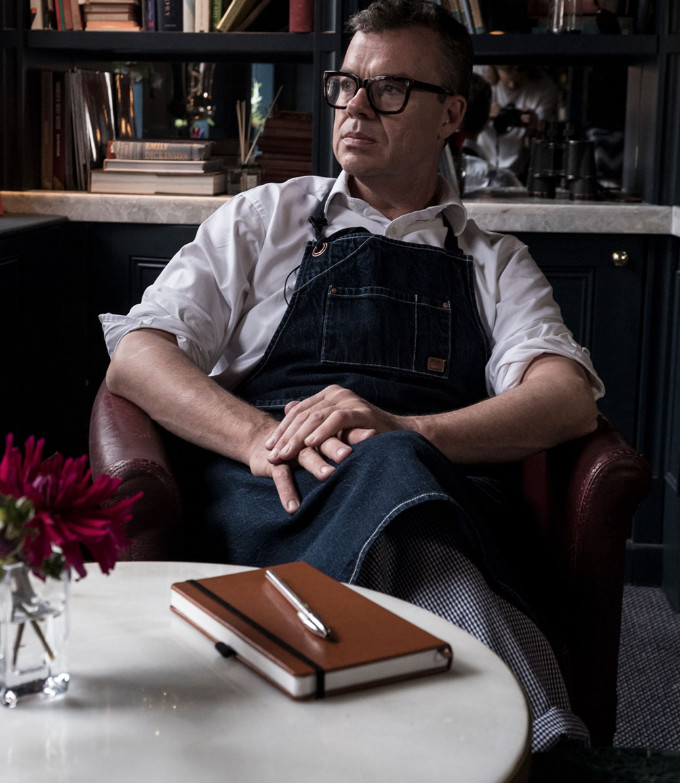What is a dish you grew up with?
My family has always been within the industry of food and beverage in some way. My mom had restaurants in Sao Paulo and my dad was in the soft-drink business. At one point about 30 years ago, there was a boom for kilo restaurants, where there’s a mixed selection of food, including hot and cold salads, where people can fill their plate with whatever they want, weigh it out and pay for how much they want to eat. Now, it is quite common around Brazil, being a typical place people go for lunch. My mom used to run one of them which is the restaurant environment I remember growing up in. My mom was more on the business side of the restaurant, she wasn’t the chef in the kitchen cooking. I guess the home cooking came more from my nan’s side.
I would have snacks there most afternoons after school, and used to love the meat croquettes they made at the restaurant which I would usually have with a Fanta – one of my favorite childhood memories. Sometimes my mom would try to get me involved by helping out. I remember being in the kitchen with the chef cooking coxinha one time. It was a fun environment for a kid but I never really was interested in cooking back then. I was like any young kid growing up; I loved sports, and spent most of my days playing football. It wasn’t until I came over to the UK in my 20s that I started getting into cooking, which was an accident in a way.
“I still love it when my mom makes quite a simple chicken pie that we eat cold as well.”
I’ve always enjoyed food, and have always been quite fussy, as well, growing up. I always had my steaks well done and could never have blood on my meat so things are very different now! My nan used to live a little bit further away from us but we used to spend a lot of time with my grandparents growing up. There was always food on the table in terms of fresh bread and cakes, and I remember making pizzas with her as well as traditional rice and beans or meat and fish mains. There was food from all over, and with my mom or nan, food is always tasty.
I still love it when my mom makes quite a simple chicken pie that we eat cold as well. I think the pie she makes is traditional Brazilian; I haven’t seen anything like it here in the UK. It’s not like a pie you can buy in supermarkets as it is made with catupiry cheese – which is a softer cheese – and is why it is better homemade.
She makes a shortcut pie pastry with a filling made from a whole cooked shredded chicken, and she then adds stock, maybe thickened up with flour, and some peas as well. Then she would add this soft catupiry cheese to add a lot of creaminess. That goes in to coat everything and hold it all together. Quite commonly people eat it cold or at room temperature. It’s quite firm and there’s a lot of chicken in there. We would have it quite often in the afternoons.
What is the first recipe you remember following?
I worked in one London restaurant before I moved to Italy where I worked for three years. I think there is one standout dish, which is actually one of my favorite things to eat, the aubergine parmigiana. We deep fry the aubergine with eggs and flour, it’s so delicious. There might be regional differences but the one I was taught was the deep fried version, and I always stuck with that.
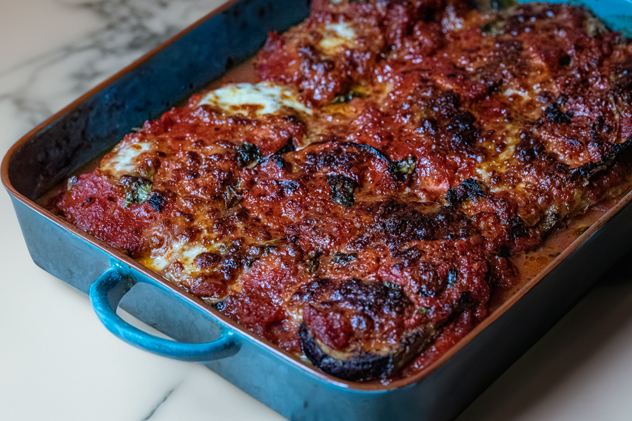
As well as fine dining, we’d cook more traditional dishes because the restaurant was in a five star luxury hotel. So we had not only fine dining in the evening, but if a guest wanted to have lunch from the hotel, we had a selection of pastas and more simple options.
It wasn’t so much about a particular dish but about the environment that motivated me to carry on. In Italy, for example, you learn more specifically about pastas, different types of sauces, and the specific way Italians approach fine dining. And then I went to Spain and learnt more about avant garde cuisine, and how to inspire yourself from the classics.
“Sometimes if you mess around with the traditions too much, you end up losing the essence of the dish.”
We have a beef parmigiana in Brazil, that’s inspired from the parmigiana in Italy to which we add chicken or beef. You have the tomato sauce and cheese on top, and it is baked in the oven like the original version. It’s not fine dining, but to me it doesn’t always have to be.
People can be fussy about little things, but I find that’s because the culture can be stubborn. I like to do whatever I want, as long as it tastes good. During lockdown I made a spaghetti amatriciana for the Michelin website and in my recipe I stated garlic and onions as a base which got some bad comments. I don’t really mind because what’s most important to me is to create a recipe that tastes good and that people will enjoy. I like to challenge traditions especially if it is for the sake of cooking good food.
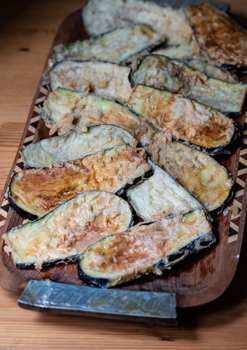 To make the aubergine parmigiana, I cut the aubergine, salt it, season it and leave it for about ten to fifteen minutes so it loses all the water. Make sure you dry the aubergine really well, then dip it in flour and a mix of whole beaten eggs, then just deep fry it straight away in sunflower oil.
To make the aubergine parmigiana, I cut the aubergine, salt it, season it and leave it for about ten to fifteen minutes so it loses all the water. Make sure you dry the aubergine really well, then dip it in flour and a mix of whole beaten eggs, then just deep fry it straight away in sunflower oil.
Fry it for a few minutes on both sides, take it out and drain it really well. You don’t have to use these straight away, if you want to do them a day ahead it’s absolutely fine.
Then you make the tomato sauce separately. I like using fresh tomatoes as it needs to be cooked for a good few hours, by tradition. I also like to put garlic and basil in my base. Then you just build it like a lasagna with layers. I like to put in some buffalo mozzarella and shaved parmesan on each layer, then you add the tomatoes, season it and bake.
The best thing is to do it the day before so you can heat it the next day and you get more flavor in there for some reason. It just intensifies the flavors. It’s something you can eat every day.
Sometimes if you mess around with the traditions too much, you end up losing the essence of the dish. In Spanish cuisine, you learn to enjoy the simplicity of the incredible produce at hand, and try to not alter the original ingredient taste too much throughout the recipe. If you use too many spices or condiments, you end up ruining the essence of the ingredient which gives overly complicated dishes in flavor. It makes you to want to experiment with ingredients, although learning the basics is essential, which starts with knowing the ingredients you work with and mastering simple flavor combinations.
What is the recipe you’ve made the most?
We have a Moqueca stew, which has been on our menu for a while, and even if it does come off, I’m sure it will come back on again.
Opening Da Terra was a reconnection to my own origins. I felt lost in a way. The name Da Terra means ‘from the earth’, the idea being not to forget where you come from. I like to think that I’m still exploring Brazilian cooking. I do that through working with native ingredients that I haven’t worked with before, or exploring regional dishes.
So when I’m in Brazil I try to visit different places and try the local food. Moqueca is a fish stew I came across in Bahia, a region of Brazil in the North West. It’s very popular in Brazil, but one that few people know about outside of the country.
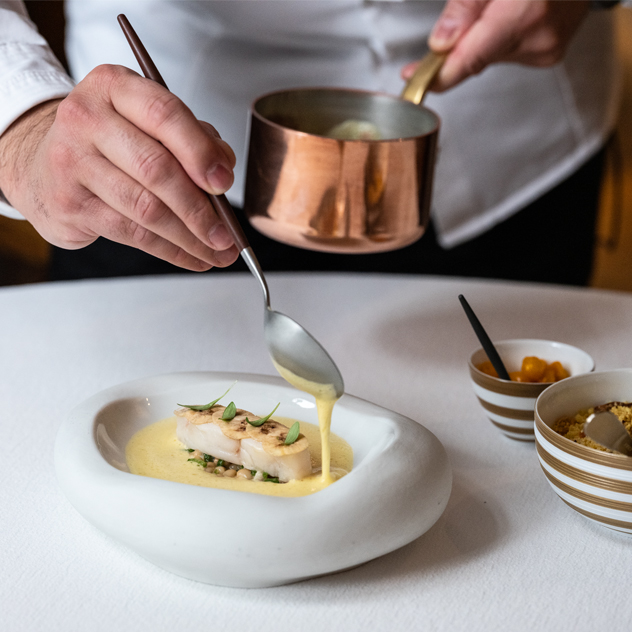
It is quite a simple fish stew, but has some distinct flavors that make it very unique. There is coconut cream, which would have been an ingredient introduced to that coast of Brazil from Portuguese sailors, and also dendê oil, which is the one ingredient that has to be there if you want to call it a Moqueca from Bahia. Dendê is red palm oil pressed from the fruit of oil palm trees and has a beautiful bright orange-red color. It’s a very traditional ingredient in that region, and is often used for deep frying fish. Eaten raw it has a powerful bitter flavor, but when cooked it has a subtle nutty taste. It’s a great ingredient to use because not only is it very traditional, but it offers a flavor that people aren’t familiar with.
To make this dish we start with a paste of dried shrimps, garlic, coriander, ginger and a little of the dendê oil. This paste is fried with a little butter, then we add in onion, peppers and tomatoes. That’s the base of the dish.
“This is the most Brazilian dish we have on our menu. It’s a dish that is still evolving”
Cook it gently until soft, then add fish stock. We make a bisque, but generally you can use any fish stock, including prawn or langoustine heads, lobster shells, anything to help give the stew that depth of flavor. Then add the coconut cream. I use a Brazilian style of coconut cream, which is generally thicker, sweeter and a little more rich.
For a traditional version of this dish, this would all be done in a clay pot and you would add in a local meaty fish like grouper or pintado, put it in the oven and gently cook until that fish has been nicely poached.
But with my version I’m using that base as a sauce. So we pass it and just use the liquid. Our Moqueca uses turbot fish. We age the fish in-house and it’s poached in brown butter.
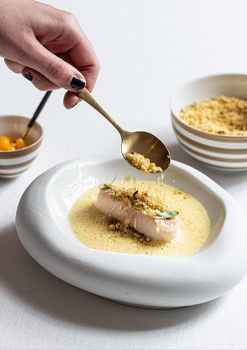 We add lime and fresh herbs to the Moqueca sauce, so it has sweet, sour and salty notes. We garnish the fish with pickled plantain, which is sliced very thinly to look like fish scales. That provides another burst of acidity to the dish.
We add lime and fresh herbs to the Moqueca sauce, so it has sweet, sour and salty notes. We garnish the fish with pickled plantain, which is sliced very thinly to look like fish scales. That provides another burst of acidity to the dish.
On the side we serve Manteiguinha beans that are cooked in a pressure cooker with fish stock, then finished in a pan with butter and smoked eel, along with farofa, a traditional Brazilian side made of toasted cassava flour. We mix in hen-of-the-wood mushrooms and Brazilian nuts into the farofa to add more depth of flavor.
Despite turbot not being a fish you’d find in Brazil, this is the most Brazilian dish we have on our menu. It’s a dish that is still evolving, but with elements that can be swapped in and out, it’s free from seasons and could live on our menu forever.
Who are the cooks or chefs whose recipes have inspired you?
It’s all about stages of your life and career. When I moved to the UK twenty years ago, I did not have such a strong interest in food as when I started working in the industry. I think the iconic chef that was everywhere at the time was Jamie Oliver. People might agree or not, but here was this young, super charismatic guy, just cooking. The food he made in his TV shows and books looked like it was bursting with flavor. To me he made it look cool and easy.
Nowadays, we have so many good talents. But at that time, Alex Atala was the number one Brazilian chef. I would say he inspired me to think more about exploring my roots. But not only for me, he’s done a lot for Brazilian cuisine in general. He was part of a generation of chefs that opened our eyes to new flavors and ingredients that were native to Brazil.
There are lots of other chefs I met throughout my career and have inspired me along the way. They may not have had the most amazing restaurants, but these chefs were amazing at trying to make a change, and they happened to have had a big impact on me at that stage in my life.
What is the recipe you would hand down to your family?
I’m not particularly emotional about my recipes, but a dish that comes to mind is a quail dish which is currently in development. It’s inspired by a dish in Brazil; slow cooked rice with chicken and okra.
I wanted to make a dish based on this but moving away from chicken, because we already have had the Humble Chicken on the menu, a dish that was designed to use all the parts of the chicken. So I decided to use quail as the flavor profile is similar.
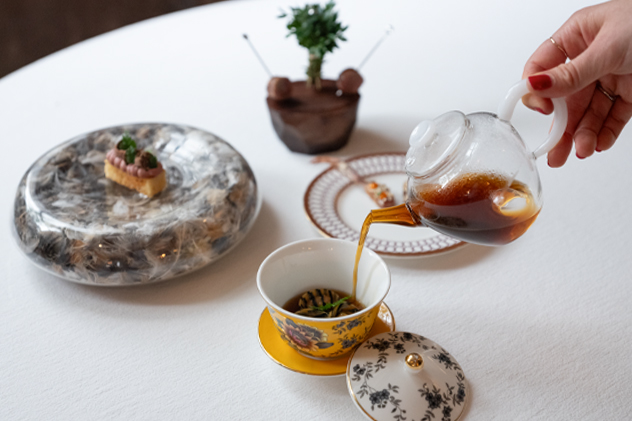
The dish is a mixture of different ideas; the idea of using tortellini in brodo, a classic Italian dish, came next. To make it, we use trimmings of the quail blitzed up as the filling for the tortellini. You can add other flavors such as onions, but I want to keep it clean. That sits in a consommé made using the carcass of the quail – again, I try to use the whole bird.
The second element is the claws, which are confitted and deboned, sprinkled with popcorn and topped with a set gel mousse which we make out of quail egg. We use the liver to make a parfait, and some parts of the breast to make pastrami. That sits on top of a brioche with black truffle.
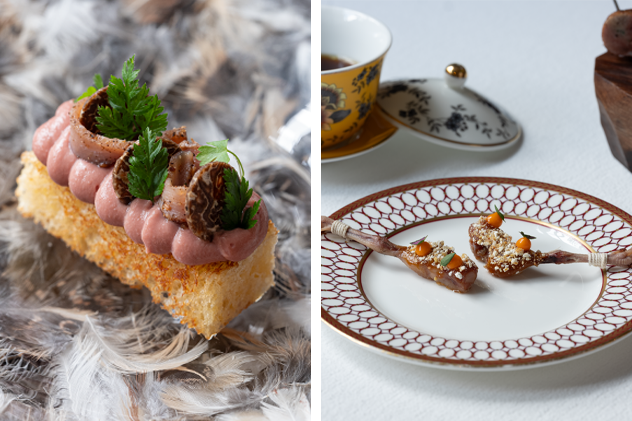
I have strong memories of certain dishes in Brazil, and while my aim is to replicate those flavors, the dish often ends up looking completely different to the original, using totally different elements. But dishes evolve; you put an idea on a plate and it matures. It evolves like your own face through different stages of your life. I find that exciting because you grow together with the dish.
Thinking about it that way, a dish has to die because it’s part of the cycle of life. It’s sad, but you move on.
What is a dish on your current menu that represents your approach to cooking?
The Da Terra menu as a whole is a journey, one that represents who I am as a person. But one dish that’s just come off the menu, and is one of my favorites, is duck raviolo. I think it represents how I like to approach each dish. The technical aspect comes from the pasta. We use two colors of pasta to create very clean lines. We also use the whole duck in different elements, and other leftover produce in the form of whey from our butter.
The dish has Italian influences, but you could also say it’s an English-influenced dish because the duck is from here.
We confit the duck legs in its own fat to keep the flavor profile in there, shred it, and then we add duck sauce. We reduce confit shallots and add some parsley and lemon zest to the mix too. That’s the paste for the filling. The whey from the butter with a little cream makes a frothy sauce to finish the dish. This provides the acidity to clean up the slight heaviness of the filling.
I make quite classic pasta dough, using a lot of egg yolks as well as semolina. It depends what you add it to, but classically I would say 700g of 00 flour and 300g semolina, plus egg yolks and a little bit of egg white to make it more manageable – but I prefer to stick to as much egg yolk base as possible.

Adriana Cavita
LONDON, UK
"I need to balance traditional preparation with modern techniques. I can use traditional recipes as the basis of my creations, but I must also tap into my imagination and passion to create something new and unique."

Chetan Sharma
LONDON, UK
"For any young British Asian chef, or any chef interested in Indian cooking, I want them to be able to come into this restaurant and understand Indian food and Indian flavors, but also learn techniques and be open minded."

Chris Leach
LONDON, UK
"There are quite a lot of recipes I’m proud of, but there are a few that I feel are genuinely original to me. My pig skin ragu recipe is one of those. There is no meat, or rather, flesh, in the dish; it's made from just pig’s skin."

Andrew Clarke
LONDON, UK
"My mum didn't care I was a professional cook. She was going to cook what she wanted to cook, and love what she was doing. And there’s an honesty and beauty to that."




